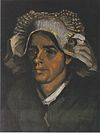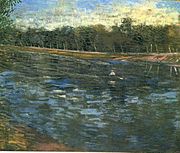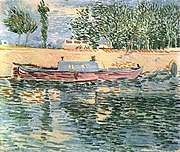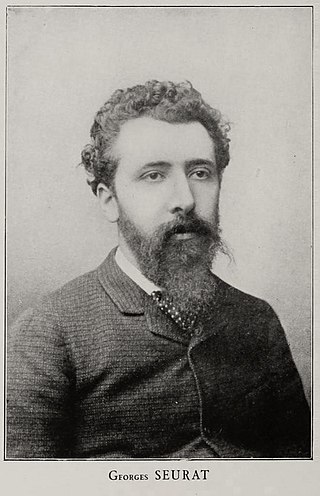
Georges Pierre Seurat was a French post-Impressionist artist. He devised the painting techniques known as chromoluminarism and pointillism and used conté crayon for drawings on paper with a rough surface.

Post-Impressionism was a predominantly French art movement that developed roughly between 1886 and 1905, from the last Impressionist exhibition to the birth of Fauvism. Post-Impressionism emerged as a reaction against Impressionists' concern for the naturalistic depiction of light and colour. Its broad emphasis on abstract qualities or symbolic content means Post-Impressionism encompasses Les Nabis, Neo-Impressionism, Symbolism, Cloisonnism, the Pont-Aven School, and Synthetism, along with some later Impressionists' work. The movement's principal artists were Paul Cézanne, Paul Gauguin, Vincent van Gogh and Georges Seurat.

Pointillism is a technique of painting in which small, distinct dots of color are applied in patterns to form an image.

Paul Victor Jules Signac was a French Neo-Impressionist painter who, with Georges Seurat, helped develop the artistic technique Pointillism.

A Sunday Afternoon on the Island of La Grande Jatte was painted from 1884 to 1886 and is Georges Seurat's most famous work. A leading example of pointillist technique, executed on a large canvas, it is a founding work of the neo-impressionist movement. Seurat's composition includes a number of Parisians at a park on the banks of the River Seine. It is held in the collection of the Art Institute of Chicago.

Neo-Impressionism is a term coined by French art critic Félix Fénéon in 1886 to describe an art movement founded by Georges Seurat. Seurat's most renowned masterpiece, A Sunday Afternoon on the Island of La Grande Jatte, marked the beginning of this movement when it first made its appearance at an exhibition of the Société des Artistes Indépendants in Paris. Around this time, the peak of France's modern era emerged and many painters were in search of new methods. Followers of Neo-Impressionism, in particular, were drawn to modern urban scenes as well as landscapes and seashores. Science-based interpretation of lines and colors influenced Neo-Impressionists' characterization of their own contemporary art. The Pointillist and Divisionist techniques are often mentioned in this context, because they were the dominant techniques in the beginning of the Neo-Impressionist movement.

Asnières-sur-Seine is a commune in the Hauts-de-Seine department and Île-de-France region of north-central France. It lies on the left bank of the river Seine, some eight kilometres from the centre of Paris in the north-western suburbs of the French capital. The area should be reached by line 15 of the Paris metro by 2030. The inhabitants are called the Asniérois and the Asniéroises in French.

Théophile "Théo" van Rysselberghe was a Belgian neo-impressionist painter, who played a pivotal role in the European art scene at the turn of the twentieth century.

Charles Angrand was a French artist who gained renown for his Neo-Impressionist paintings and drawings. He was an important member of the Parisian avant-garde art scene in the late 1880s and early 1890s.
Events from the year 1886 in art.

Divisionism, also called chromoluminarism, is the characteristic style in Neo-Impressionist painting defined by the separation of colors into individual dots or patches that interact optically.

Bathers at Asnières is an 1884 oil on canvas painting by French artist Georges Pierre Seurat, the first of his two masterpieces on the monumental scale. The canvas is of a suburban, placid Parisian riverside scene. Isolated figures, with their clothes piled sculpturally on the riverbank, together with trees, austere boundary walls and buildings, and the River Seine are presented in a formal layout. A combination of complex brushstroke techniques and a meticulous application of contemporary color theory bring to the composition a sense of gentle vibrancy and timelessness.

The Île de la Jatte or Île de la Grande Jatte is an island in the river Seine, located in the department of Hauts-de-Seine, and shared between the two communes of Neuilly-sur-Seine and Levallois. It is situated at the very gates of Paris, being 7 km distant from the towers of Notre Dame and 3 km from the Place de l'Étoile. The island, which has about 4,000 inhabitants, is nearly 2 km long and almost 200 m wide at its widest point. Its name translates as "Island of the Bowl" or "Island of the Big Bowl".
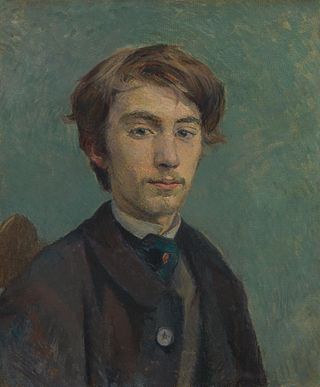
This is an Émile Bernard chronology of the life and career of French artist, art critic and writer Émile Bernard, based on documents hitherto published - however, most of the relevant sources remain unpublished. To a certain extent, these gaps can be filled by information derived from letters and biographies of e.g. Vincent van Gogh, Paul Gauguin and Émile Schuffenecker. Bernard and his work is associated with Post-Impressionism, Cloisonnism and Synthetism.

A Woman Walking in a Garden is an oil-on-canvas painting by Dutch Post-Impressionist painter, Vincent van Gogh. This painting was created in 1887 during the two years van Gogh lived in the northern suburbs of Paris. There is a woman walking through a lush and green garden dotted with flowers and in the background there is a building concealed behind a thick row of trees. A red paint border along the edge of the canvas frames the scene.This painting is a part of the Riverbank in Clichy Triptych along with Fishing in Spring housed at the Art Institute of Chicago and River Bank in Springtime housed at the Dallas Museum of Art. All three pieces have red borders as to indicate their association to each other in a triptych.

Asnières, now named Asnières-sur-Seine, is the subject and location of paintings that Vincent van Gogh made in 1887. The works, which include parks, restaurants, riverside settings and factories, mark a breakthrough in van Gogh's artistic development. In the Netherlands his work was shaped by great Dutch masters as well as Anton Mauve a Dutch realist painter who was a leading member of the Hague School and a significant early influence on his cousin-in-law van Gogh. In Paris van Gogh was exposed to and influenced by Impressionism, Symbolism, Pointillism, and Japanese woodblock print genres.

The Montmartre paintings are a group of works that Vincent van Gogh created in 1886 and 1887 of the Paris district of Montmartre while living there, at 54 Rue Lepic, with his brother Theo. Rather than capture urban settings in Paris, van Gogh preferred pastoral scenes, such as Montmartre and Asnières in the northwest suburbs. Of the two years in Paris, the work from 1886 often has the dark, somber tones of his early works from the Netherlands and Brussels. By the spring of 1887, van Gogh embraced use of color and light and created his own brushstroke techniques based upon Impressionism and Pointillism. The works in the series provide examples of his work during that period of time and the progression he made as an artist.

Still life paintings by Vincent van Gogh (Paris) is the subject of many drawings, sketches and paintings by Vincent van Gogh in 1886 and 1887 after he moved to Montmartre in Paris from the Netherlands. While in Paris, Van Gogh transformed the subjects, color and techniques that he used in creating still life paintings.

Imperial Fritillaries in a Copper Vase is an oil painting on canvas created by the Post-Impressionist painter Vincent van Gogh in Paris, 1887. The painting is now part of the collection of the Musée d'Orsay in Paris, France. This work was made at a time of the life of Van Gogh when he first encountered influences from Impressionists and became aware of light and color, implementing it in his paintings. This painting presages some of his most famous subsequent works, and stands out from other still lifes because of the implementation of mixed techniques and complementary colors.



